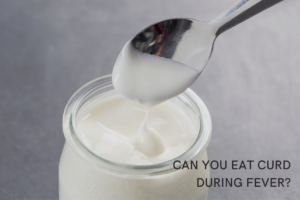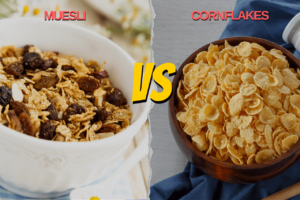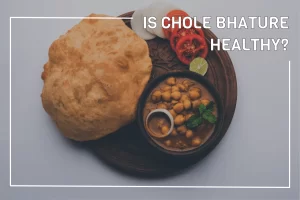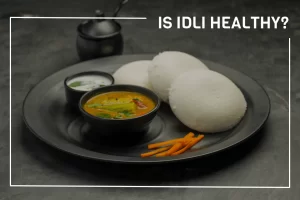Are you a fan of momos and wondering if they are good for your health? You are not alone.
Momos are one of the most popular street food in many parts of the world, especially in countries like Nepal and India. They are made by stuffing a dough wrapper with a filling, which typically includes chicken, soyabean, paneer, or vegetables.
And while momos are a tasty and convenient snack on the go, are they healthy to eat?
Short answer: Momos are not healthy as they have a high calorie content, are made with refined flour, have low nutritional value, and are high in sodium. In addition they may contain harmful ingredient like MSG.
Below, I have listed 9 big reasons why momos are not the healthy choice for you.
Let’s start.
Also read: 4 Reasons Why Chole Bhature Isn’t Healthy For You
9 Reasons Momos Are Not Healthy For You
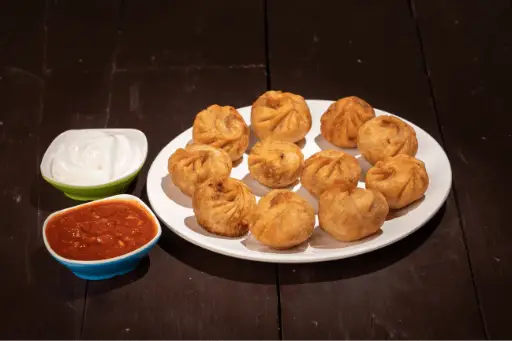
Momos are high in calories
Whether you eat steam, fried, or gravy momos, they are all high in calories.
On average, a single piece of steam momos has 35 calories, and a plate of momos which usually comes with 6 pieces, can easily contain 210 calories.
Fried momos are more calorie-dense than their non-fried counterparts due to the addition of calories from the deep-frying process. A single plate of fried momos can contain up to 900 calories. These extra calories come from the coatings, including batter, flour, and the oil that sticks to the momos after cooking.
If you are someone who regularly eats momos or consumes high-calorie foods, this can lead to many health issues such as:
- Weight gain
- Obesity
- Type 2 diabetes
- Dementia
- Osteoarthritis
- Brain shrinkage
| Momos | Calories in steam(per plate) | Calories in fried(per plate) |
|---|---|---|
| Veg | 210 | 900 |
| Non-veg | 390 | 1200 |
| Paneer | 300 | 1000-1100 |
DID YOU KNOW? When eating Fried veg momos, it only takes 10 minutes to consume 900 calories. However, on average, it takes 6 hours of walking, 1.5 hours of jogging, or 60-70 minutes of cycling to burn the same amount of calories.
Momos are made with maida
Maida (refined flour) or maida-based foods are one of the unhealthiest types of foods that you can eat on the street.
Maida is a highly processed form of white flour that is often used in Indian cooking. It is made by stripping away the outer layer of wheat grain, which contains most of the fiber and nutrients. What remains is a starchy endosperm that is milled into a fine powder.
Whether it’s steam, paneer, or any other type of momos, they’re all made of maida, making them highly unhealthy to eat.
Consuming excess maida can lead to a host of problems like:
- Disrupt the blood sugar levels
- Raises cholesterol levels
- Causes mood swings
- Weight gain
- Diabetes
- Gastrointestinal problems
- Heart disease
Also read: Is Maida Good For Health? The Truth About This Indian Staple
Momos are often deep-fried
Who doesn’t love that crunchiness of the fried momos with mayonnaise? Oh, that’s delicious. But let me tell you that fried momos are the unhealthiest types of momos that you can eat as they are repeatedly deep-fried in the same oil.
You’ll notice that the oil in which momos are deep-fried turns dark, greasy, and thicker than usual, indicating that the oil has gone bad and it’s time to discard it. However, the momos vendor continues to fry momos in that oil.
Do you know what happens when we keep reheating the same oil? It makes oil carcinogenic.
Eating fried momos cooked in oil that is reused and reheated throughout the day raises free radicals in the body, leading to inflammation, which is the root cause of most diseases such as obesity, heart disease, and diabetes.
According to studies, reusing oil can also lead to the formation of harmful compounds known as polycyclic aromatic hydrocarbons (PAHs), which have been linked to cancer.
Other health risks associated with eating food cooked in reheated cooking oil include:
- Acidity
- Increase in cholesterol levels
- Weight gain
- Irritable throat
- Alzheimer’s disease
Momos and risk of unhealthy ingredients
While momos can be a tasty and convenient option, they are often filled with low-quality ingredients.
You can never trust the freshness of fillings in your momos. Are the vegetables fresh? Have they been washed properly? Is paneer used in filling of good quality? Is the chicken fresh?
The vegetables used for fillings are often not cooked and washed properly. As a result, they increase the chances of getting yourself sick.
Furthermore, we have no way of knowing whether the chicken used in momos was killed specifically for the momos or was already dead because of any disease before being used in your momos. Eating such momos can result in sickness, as the chicken used is affected by viruses and full of pathogenic bacteria.
DID YOU KNOW? Momos have been originated from Tibet and came to India in the 1960s.
Momos have low nutritional value
While momos are a tasty snack, it’s important to remember that they’re not particularly nutritious. You might think that momos are filled with vegetables, but we don’t know how fresh they are, and the amount of vegetables is minimal.
A typical momo contains little protein, fiber, vitamins, and minerals. In fact, most of the calories in a momo come from fat, carbohydrates, and sugar.
So, if you think eating momos will give you an energy boost and help you meet your daily nutritional goals, you’re wrong. However, if you’re simply looking for something to satisfy your hunger, you can eat momos.
But don’t forget momos are low in fiber, so your hunger will return after a while, and your body will crave food again.
Momos and risk of weight gain and obesity
Street food is one of the major contributors to weight gain and obesity.
Because momos are made with maida and are high in calories, simple carbs, and sodium, eating them on a regular basis will only add to your waistline.
Also, maida has a high glycemic index of 71, which causes rapid spikes in blood sugar levels and leads to weight gain in the long run.
The risk of obesity is more in children and youth as fast foods affect them worse than adults.
Furthermore, studies suggest that obesity is linked to several long-term health issues like diabetes, heart disease, gall bladder disease, fatty liver, arthritis, and some cancers.
Momos may contain MSG
You might initially think restaurant momos are better than street momos as professional chefs make them in big kitchens with fresh ingredients.
However, most restaurants add MSG to their momos to make them more attractive and improve their taste. Although this may be appealing to your taste buds, it can be detrimental to your health.
MSG or monosodium glutamate or Ajinomoto is a common food additive that has been used for centuries. Despite its widespread use, it has been associated with various toxicity.
According to studies, overconsumption of MSG has been linked to obesity, metabolic disorders, Chinese Restaurant Syndrome, neurotoxic effects, and detrimental effects on the reproductive organs.
DID YOU KNOW? MSG is the same food enhancer that led to the Indian government banning Maggi in 2015.
Momos come with spicy sauces
The sauces that are commonly served with momos can be high in sugar, salt, and fat, which can all contribute to health problems. While these sauces may be delicious, you must be mindful of how much you consume.
Sometimes vendors make red sauces that are too spicy for your digestive system, which can result in abdominal pain and diarrhea. This is especially common for people who have weak digestive systems.
Plus, the most loved chutney with momos, mayonnaise, is also high in calories and fat. This causes the momos to be even more calorie-dense than they are.
Momos and lack of hygiene
Not only the momos but all the other street foods such as samosa, jalebi, and chole bhature has been observed to be made in very unhygienic surroundings, therefore threatening to expose you to various diseases.
Poor hygiene when handling food can lead to foodborne illness, which can be very dangerous, especially for vulnerable populations like children.
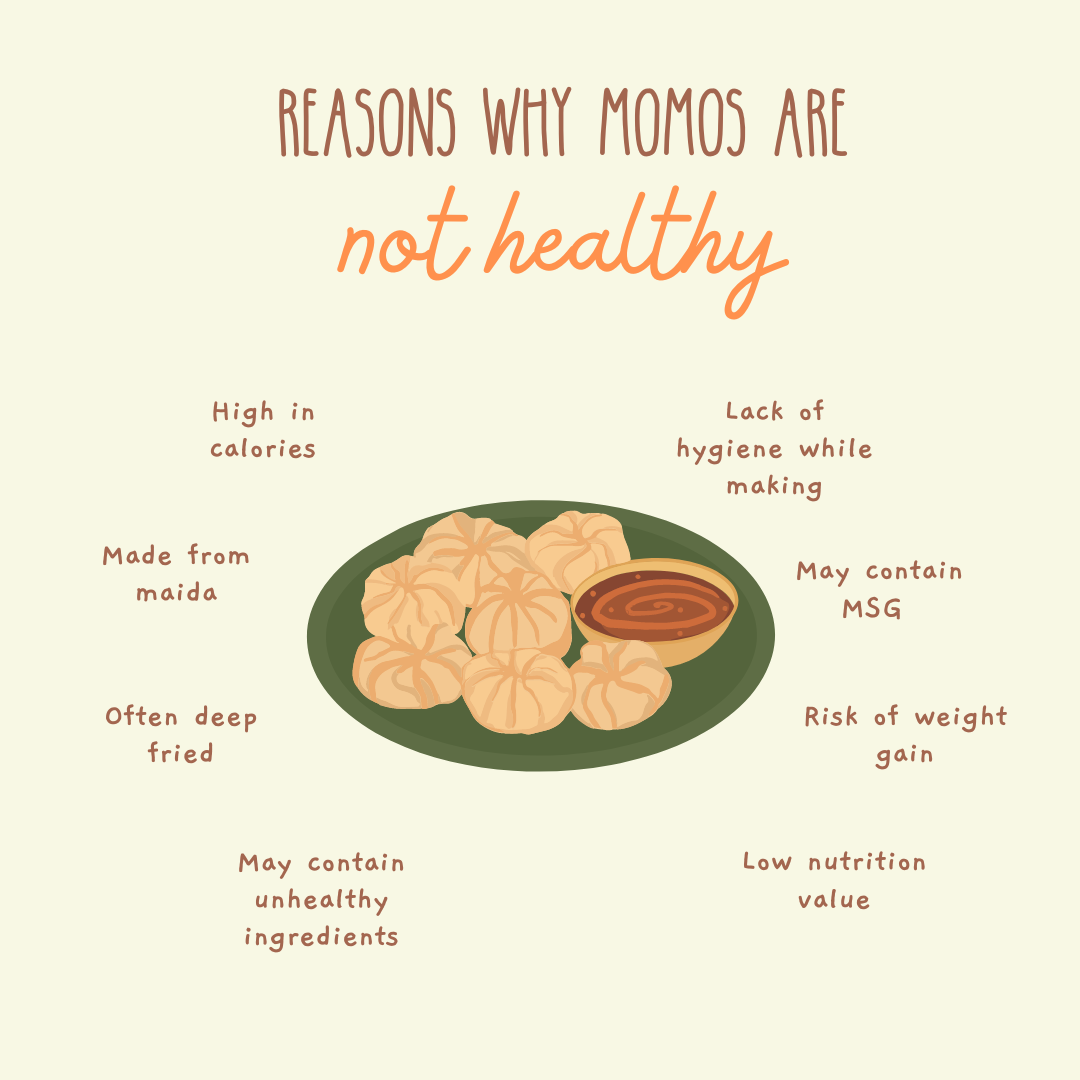
Should you completely avoid eating momos?
Not only to the momos, but the reasons I have given above also adhere to many other street foods.
However, should you completely avoid eating momos or other street foods?
Well, no, because most vendors and their families depend on their street food work. However, you must be careful about what you eat and consume it in limited amounts. In this way, you can help support small vendors, and at the same time, you can make a positive impact on your health.
In the case of momos, it is better to stick to well-cooked steam momos, as they are far healthier than their fried counterparts.
If possible, try to make momos at home, as this will give you control over all the ingredients that go into making them.
Here are some tips to make your momos eat healthily:
- Always eat steamed momos instead of fried ones.
- Avoid the regular chilli sauce or atleast limit your intake as it is high in salt, sugar, and sodium. Instead, if you have the option, go for mint or coconut chutney.
- While cooking at home, replace maida with whole wheat atta to make healthier momos. They may taste different, but they are indeed healthier for you.
- While cooking at home, you can mix soybean and chopped fresh vegetables as filling. You have complete control over your fillings, so you can add anything you want.
Final words
Momos might be the delicious street food you can find, but they are not healthy for you. They are extremely high in calories, are made with refined flour, have low nutritional value, are high in sodium and may contains MSG.
In addition, momos are often deep fried in reused refined oil, which raises the trans fat content and increases the risk of life threatening diseases.
There are many other healthier alternative to momos. You could make your own momos at home using healthier ingredients, or you could choose to eat other types of street food that are nutritious.
Either way, it’s important to be aware that momos selling on the streets are not particularly healthy and should not be eaten too often.
Found this information helpful? Share it.
Here are a few other posts that might be helpful for you:
- Is Idli Healthy? 7 Benefits You Need To Know
- Is Upma Healthy? 8 Benefits Of This Forgotten Breakfast
- Is Dhokla Healthy? 8 Reasons To Include In Your Diet
- 8 Benefits Of Dosa That Makes It An Incredibly Healthy Dish
FAQs about momos
Steamed momos are better than fried momos, but they are also made from refined flour, are high in calories and low in nutritional value, which makes them unhealthy.
Momos are not good for weight loss as they are extremely high in calories and sodium and are made from maida.
Momos and dumplings are similar in that they are both small, stuffed pockets of dough that are cooked by boiling or steaming.
However, important thing to note here is that momos are dumpling but not every dumpling is momos.
It is generally safe to eat momos during pregnancy, as long as they are cooked properly and made with healthy ingredients. It would be beneficial to eat home made momos rather than street momos during pregnancy.
It is possible that momos served in restaurants or hotels may contain ajinomoto, but it is less likely to be present in street momos due to a lack of popularity among street vendors.
Momos contains Ajinomoto which might effect the blood pressure and cause stomach-related problems. However, there’s no valid scientific evidence that proves eating momos causes cancer.
The number of calories in chicken momos will depend on the size of the momos and the ingredients used. On average, a plate of medium-sized steamed chicken momos can contain around 390 calories, while a plate of fried chicken momos can contain around 1200 calories.

